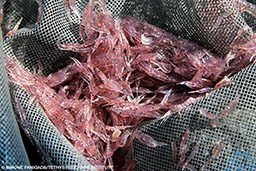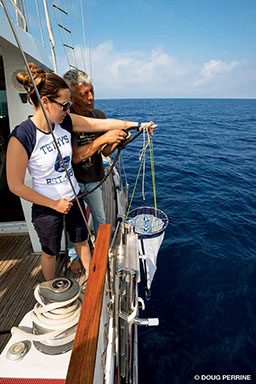Strapped into the bow of a small inflatable boat, holding a crossbow and scanning the water intently, Simone Panigada, Ph.D., was patrolling the coast of Lampedusa, a small Italian island. A sudden flash of reflected sunlight alerted him to something on the surface just ahead. He signaled Giancarlo Lauriano at the helm, and the boat lurched forward, racing at full speed. Panigada raised his crossbow and fired.
The projectile arced across the water, striking its target with two sharpened points that buried into flesh, securing a barnacle-sized packet of electronics to the dorsal fin of a fin whale. The Low Impact Minimally Percutaneous Electronic Transmitter (LIMPET) tag would attempt to contact an Argos satellite every time the whale surfaced, transmitting the animal’s position for the next six weeks.
Almost simultaneously, Nino Pierantonio, Panigada’s colleague at the Milan-based Tethys Research Institute, fired another crossbow, which launched a hollow-tipped arrow at the whale’s flank. The arrow struck the whale and then fell into the water, cradling a small plug of skin and blubber for analysis of DNA and toxins. The whale reacted to both insults with a small twitch, as if stung by a mosquito, and returned to its business.

That business was the ingestion of massive quantities of krill, which were swarming in sufficient density to stain the blue surface water a startling pink. The krill, normally found hundreds of feet deep, were feeding at the surface due to massive upwellings that bring cold nutrient-rich water to the surface around Lampedusa during the first few months of each year. The upwellings result from the interaction of deep currents with dramatic bottom topography.
Fin whales have been known to inhabit the northern Mediterranean during the summer since ancient times — Romans referred to Italy’s Ligurian (northwestern) coast as the “coast of whales”— but rumors of winter feeding aggregations around Lampedusa (in the southern Mediterranean) were not confirmed until 2004. Researchers found that the whales not only were feeding out of season but were doing so right at the surface and throughout the day. Fin whales in the Ligurian Sea (the area of the Mediterranean south of Italy’s Liguria region and north of the island of Corsica) feed mostly at night and at depth. Around Lampedusa, the whales were also feeding in groups, possibly collaborating to herd prey — a behavior not previously recorded in Mediterranean fin whales.
The question that most bedeviled Tethys founder Giuseppe Notarbartolo di Sciara was if these whales belonged to a separate southern Mediterranean population or if they were the same whales his organization was studying during the summer in the Ligurian Sea near the border of France and Italy.

The fin whale is one of the most mysterious and elusive large animals on the planet and is in many ways an oddity of the animal kingdom. In nearly all vertebrates the left side of the body is a mirror image of the right. Fin whales are an exception. The lower jaw on the left side is a typical whale gray, while on the right it’s a brilliant white. The right dorsal surface has swirling patterns known as “blaze and chevron” that are unique to each individual and allow the Tethys researchers to photoidentify each whale. Scientists speculate that the reflectivity of the white lower jaw may be used to startle and herd prey, but any functional advantage of the blaze and chevron is harder to conjecture.
Fin whales push the extremes of the animal kingdom in speed, size and feeding ecology. They are one of the largest creatures on the planet and one of the fastest swimmers in the ocean. Calculations predict a theoretical maximum speed of around 30 miles per hour, and Pierantonio believes he has seen one swim at least that fast. (Faster estimated speeds by marlin, sailfish and dolphins are based on the animals jumping above water or riding in boat wakes.) Fin whales, which are thought to plunge to nearly 2,000 feet in the Mediterranean in search of krill, may also have the deepest feeding dives of any baleen whale.
Fin whales do not simply swim along with their mouths agape to filter plankton (as right whales do); instead they capture their prey of krill or small fish by lunging repeatedly at high speed, engulfing volumes of water that may actually be larger than the size of the whale’s body before it opened its mouth. Each lunge requires rapid acceleration and an enormous expenditure of energy. Researchers at the University of British Columbia described this process as “one of the most extreme feeding methods among aquatic vertebrates.” To fuel the intense energetic demand of maintaining and operating a huge body at high speed, fin whales must consume more than a ton of krill every day.
Fin whales can maintain high speeds over large distances when traveling between areas with large concentrations of prey. A whale Panigada tagged in March 2015 swam from Lampedusa to the northern tip of Corsica, traversing the Mediterranean from south to north in five days. It averaged more than 100 miles per day while crossing some of the world’s busiest shipping lanes. A second whale tagged the same day made a similar migration, confirming that the same whales feed seasonally on both sides of the Mediterranean.

“The fog surrounding our understanding of fin-whale movements in the Mediterranean seems to be lifting to some extent,” Notarbartolo di Sciara said. The dramatic results were more cause for concern than celebration, however. Ship strikes are the leading known cause of death in fin whales, and these whales swim close to the surface and come up to breathe regularly while migrating. The confirmation of the Lampedusa area as an important feeding ground is also of concern due to the “exponential growth of fishing effort” in the region, according to the report Panigada and his colleagues submitted to the International Whaling Commission.
Fin whales are classified as endangered worldwide. Commercial whaling has never targeted the Mediterranean fin-whale population, but ship strikes, fishery interactions, chemical pollution, sound pollution and disturbance by whale-watching operations are all significant threats. The Mediterranean fin whales constitute a genetically distinct subpopulation that has been isolated from the North Atlantic population for 200,000 years. The Mediterranean whales rarely leave the Mediterranean except for short forays into the Atlantic just beyond the Strait of Gibraltar. Researchers can distinguish Mediterranean and Atlantic whales by the unique characteristics of their calls.
After a long campaign by the Tethys Research Institute, Italy, France and Monaco created the Pelagos Sanctuary for Mediterranean Marine Mammals in 2002, making it the world’s first marine protected area (MPA) that is international and the first that is mostly in pelagic waters. The sanctuary covers almost 34,000 square miles, stretching from just offshore of the French and Italian Riviera almost to the northern coast of Corsica. It includes territorial waters of all three nations, but much of it is in international waters or areas beyond national jurisdiction (ABNJ). With the Pelagos Sanctuary as an example, the United Nations has created a process to establish additional MPAs in ABNJ, which cover 40 percent of the earth’s surface.
Marine mammals found within sanctuary waters include fin whales, sperm whales, Cuvier’s beaked whales, long-finned pilot whales, striped dolphins, short-beaked common dolphins, common bottlenose dolphins and Risso’s dolphins. Fin whales and striped dolphins are the most abundant. Sperm whales in the Mediterranean, like fin whales, constitute a distinct subpopulation characterized by a unique vocal repertoire (and possibly a smaller body size). Unlike male Atlantic sperm whales, which make enormous migrations between high-latitude feeding areas and low-latitude breeding areas, Mediterranean sperm whales are believed to spend their lives within the Mediterranean.
Scientists did not recognize the abundance of whales in this region until Notarbartolo di Sciara began studying cetaceans there in the late 1980s. Many divers, however, still believe “the Med is dead.”
“That’s not true,” said Sylvan Oehen, a member of the Tethys Cetacean Sanctuary Research team. “The Mediterranean is overfished for some species, but the primary productivity is still there, and it supports a lot of life.”
Photographer Danny Kessler was surprised and intrigued when he learned about the Tethys research while on a family vacation in Sardinia. He had assumed that the clear blue waters of the Mediterranean indicated a sterile environment, not realizing that ocean giants were diving deep to utilize food resources hundreds or thousands of feet below the surface. He was also amazed when Cetacean Sanctuary Research director Sabina Airoldi showed him maps of seasonal upwellings, and he learned that the fleet-finned fin whales could dash hundreds of miles to get from one temporarily productive area to another.

Numbers of fin whales in the sanctuary have been declining in recent years, but this may simply reflect movement out of the Ligurian Sea into other parts of the Mediterranean. Sperm whale numbers, however, appear to be increasing within the sanctuary. Similarly, common dolphin numbers have crashed, but striped dolphins are abundant. Overfishing of the primary prey species of common dolphins is suspected in their decline. Striped dolphins eat a much wider variety of prey and are thus able to prosper. Risso’s dolphin populations have declined since 2005, with abundance estimates in 2012 and 2013 only half of the average. Risso’s dolphins and Cuvier’s beaked whales feed primarily on squid, but Tethys’ studies showed that the two species were using entirely different habitats.
Almost nothing was known about Cuvier’s whales in the Mediterranean before Tethys began its research in 1999, collaborating with other researchers to describe a resident population of about 100 of these rare animals feeding in a deep canyon region off Genoa. Long-finned pilot whales, once commonly found in large pods, are now rarely seen in the sanctuary. The researchers are particularly excited when they encounter a pod, not just for the opportunity to add points to the database, but also because these whales are much friendlier than most cetaceans in the area and than pilot whales in most other parts of the world. Tethys researchers have also been involved in research seeking to manage severe threats to bottlenose-dolphin populations in the nearby Adriatic and Ionian seas.

While marine mammals continue to be its primary focus, Tethys is involved in research concerning a wide variety of species. A collaborative study with the University of Salento is looking at the increasing abundance of sea jellies in the Mediterranean and the resulting ecological, social and economic consequences. A study of giant devil rays (Mobula mobular) provided the first estimates of their abundance in the northwestern Mediterranean, and this work is continuing with Palestinian partners to show the effects of a fishery for the species off Gaza. These studies in collaboration with the Italian National Institute for Environmental Protection and Research and the International Whaling Commission are funded by the Italian Ministry of the Environment and use aerial surveys to census the rays and cetaceans as well as loggerhead turtles, bluefin tuna and swordfish.
Marine animals here as elsewhere face a variety of threats, but the unique international structure of the sanctuary poses great challenges to enacting regulations to manage those threats. Thus, Tethys works with user groups such as ferry operators, whale-watching companies and fishermen to try to mitigate the threats. Most important, the organization continues its research to enhance our knowledge of these species’ biological needs and of how they are being affected by a changing marine environment.
Explore More
Watch the video Tethys Citizen Science to see how volunteers can help with research at Tethys and enjoy close encounters with whales and dolphins.
© Alert Diver — Q2 Spring 2016